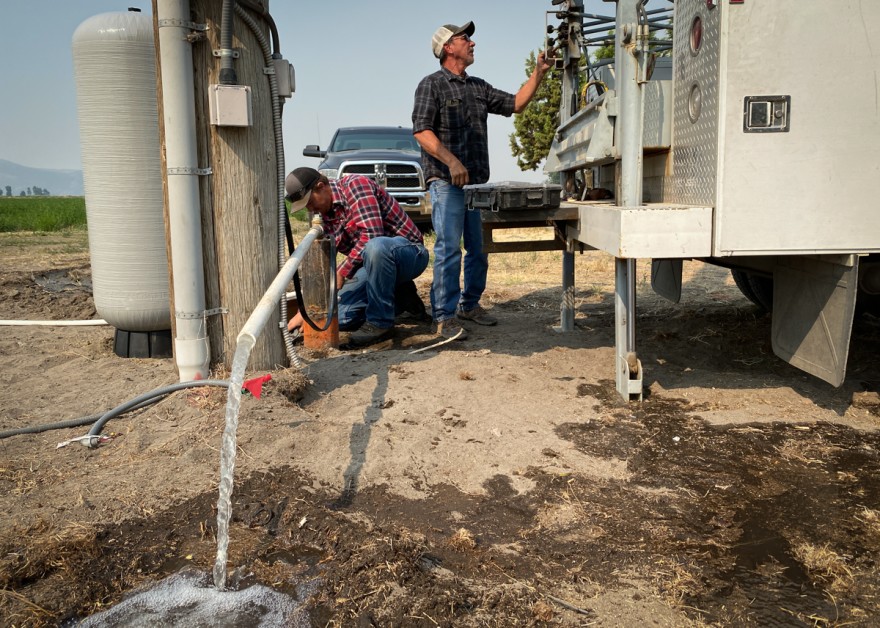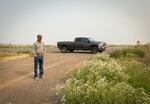
Water well pump servicers with TW Wells get a water well outside Klamath Falls running again on Aug. 5.
JPR News
Homes in rural areas of the Klamath Basin have lost running water as their wells fail. Part of the reason: more farmers and ranchers are pumping water from underground than any other year, because they didn’t get any irrigation water from a nearby lake.
In a small residential town called Midland outside Klamath Falls, Terry Smith stands in her driveway with her neighbor’s garden hose in hand.
That’s been her primary source of water since the well to her own home went dry several weeks earlier.
“I have no water,” Smith says, exasperated. “I can’t take a bath. I can’t clean my house. I can’t cook. And now my well is probably not going to work. I’ve lived in this house for 30 years. This is our retirement.”
Smith is waiting for emergency officials to fill her new storage tank with water, which will eventually be delivered in a tanker normally used for delivering milk. In the meantime, she’s been filling 5-gallon jugs with water at a filling station in Klamath Falls and taking up her neighbor’s offer to use water from their hose.
When Smith’s well stopped working, she called a contractor to drill it deeper. This was going to be a gamble, since there wasn’t a guarantee that it’d work, and she’d have to pay the contractor several thousand dollars regardless.
“I keep thinking today’s going to be the day that the [water] tank gets filled,” Smith says. “Today’s going to be the day when the well gets drilled. But it isn’t.”
Because of widespread demand, well drillers’ schedules are booked solid. When someone finally came out to Smith’s house and started drilling, the soil in her well collapsed. They drilled some more. Then it collapsed again.
Smith had reached a breaking point. She stood in her bone-dry yard that was immersed in thick, gray smoke from nearby wildfires.
“We’re literally at the end of the world,” she says.
Smith has since had her storage tank filled with water, so when she turns on the faucet, a low but steady flow trickles out. Still, she and her husband still have to be mindful of their water use. The tank holds 2,500 gallons of water. Normally, two people use about a couple hundred gallons a day.
Nearly 200 people in the Klamath Basin this summer reported their wells going dry. In response, local and federal emergency officials have delivered hundreds of the 2,500-gallon, igloo-shaped storage tanks that can hook up to people’s homes to get some water flowing through their pipes again.
When someone’s well runs dry, they can first try to drop their pump deeper into their well. That’s the equipment that pumps water from the well into pipes that run into a building. If they’ve dropped the pump as far as it’ll go and still no water turns up, then they’ll likely have to drill their well deeper, then have their pump installed again.

Ryon Freeman looks over the dry lake beds in the Lower Klamath National Wildlife Refuge on Aug. 5.
April Ehrlich | / JPR News
That means the handful of pump servicers in the region are slammed. Ryon Freeman, who owns TW Wells outside Klamath Falls, says his crew of three are working from early morning until past dark trying to help everyone who calls them.
“There are four-to-five pump outfits in Klamath Falls,” Freeman says. “We’re all running around and doing as much work as we can. It’s a little bit frustrating because you can’t get to everyone.”
Like many of the farmers and ranchers around here, Freeman points to the dry ditches as the biggest cause of people’s wells running dry.
“Without that surface water — without irrigating pastures, water flowing through the ditches — these wells aren’t recovering,” Freeman says.
Earlier this year, the federal government opted not to divert water from Upper Klamath Lake to irrigators, including farmers and ranchers, because water levels were too low. Moving water out of the lake would harm critically endangered fish species that exist only in this lake. They include the Lost River and shortnose sucker — also known as the C’waam and Koptu — which are culturally important to the Klamath Tribes.
When this region got an official drought declaration from Gov. Kate Brown’s office, that allowed farmers and ranchers to apply for emergency permits to pump water from underground. Then they flooded the state’s water agency with requests to pump groundwater.
Ivan Gall with the Oregon Water Resources Department says his office has received more pumping requests than any other year.
“And that big change in the pumping influence is largely what’s impacting these wells,” Gall says.
Squeezing what little water we can from underground, year after year, can have a cumulative impact on the aquifer system, Gall says, because that uses up the underground pools of freshwater that wells draw from faster than they can naturally refill from rain and snowfall.
“The way it’s managed today and the way that groundwater continues to be used on these really dry years, we’re going to see a pretty big drop here and we’re probably not going to dig ourselves out of this hole,” Gall says.
The Klamath Basin is getting hit hard by climate change, Gall says. Increasingly hot and dry years means less snowpack, which means less water both above and underground. That’s left businesses and homeowners competing for what’s left.
That’s turned neighbors against each other.
“I think their quickest reaction is, ‘Why am I dry? Who took my water?’” says Midland resident Justin Grant. “I think it’s real easy and real quick to just point the finger at the neighbor who has an irrigation well [that’s pumping groundwater] and is trying to irrigate crops and keep their cattle alive.”

Justin Grant stands beside his border collie in his cow field in Midland on Aug. 5.
April Ehrlich / JPR News
Grant has a foot in both worlds. The domestic well to his home has run dry and he has an irrigation well that’s pumping water for his crops and cattle. He got a water storage tank hooked up to his house. He borrows a friend’s water tanker to pull water from the irrigation well to fill his storage tank.
Now Grant and his six-year-old son are trying to use as little water as they can so they don’t have to refill their storage tank too often.
“I feel like we’re using less than maybe 600 gallons a week, which is almost nothing,” Grant says. “I can tell you I can take a shower in less than 3 minutes now.”
Grant has lived here all his life and all he’s ever wanted to do is farm. But with this struggle for water, he and a lot of people in this basin are questioning how long its agricultural economy will survive.



